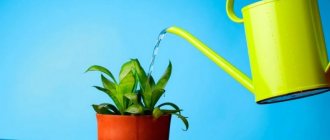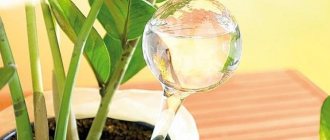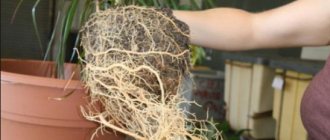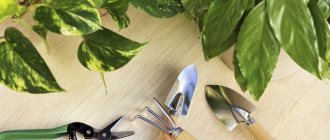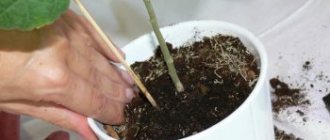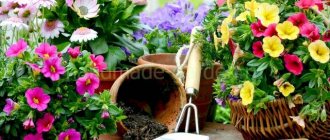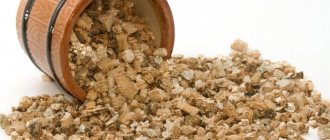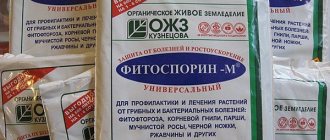Automatic watering of indoor plants during vacation
You need to use drip irrigation, a funnel, a wick, a smart pot system, or other methods. Any of these structures will protect the soil from drying out and excessive moisture, so that the plants will continue to grow fully even in the absence of the owner.
Caring for green pets
Homemade automatic watering systems
The simplest method is watering from a bottle. It’s not difficult to make such a design:
- You need to take a plastic bottle with a cap.
- Fill the container with water.
- Make a hole in the lid.
- Make several holes in the bottom to improve permeability.
- Insert the bottle into the ground with the neck down and the device is ready for use.
Important! The disadvantage of this method is that you will have to spend a lot of time and lids, selecting the rate of water flow.
Automatic watering systems from the store
If it is not possible to build a cunning structure yourself, then you need to purchase it at the store.
You can buy a polyethylene dropper or a Blumat sensor system.
A dripper for indoor plants works on the same principle as for humans, so you need to try it before you go on vacation. It is worth adjusting the moisture supply and making sure that everything will be fine with the flowers.
The Blumat system was developed by an Austrian scientist. It is a plastic cone, the tip of which is made of special clay. It is through this that moisture enters the soil. Thanks to the unique design, indoor flowers absorb the required amount of water.
Blumat system
Techniques for moistening the soil
This technique will help you survive a week without watering: move clay and ceramic pots inside plastic ones, and fill the space between them with moistened moss.
A device made from a plastic bottle will help provide watering. Even a novice gardener can make such a design with his own hands.
Holes are made in the bottom and lid of the bottle, then the bottle is fixed upside down in the pot. Before leaving, measure how long and how much liquid has gone into the ground. Then do the calculation for a day, two, and so on. Be sure to check how wet the soil of indoor plants is.
Depending on the result, change the size of the hole on the cap or the volume of the bottle. An irrigation system made from plastic containers is the least expensive, so it’s worth trying it out before you leave.
Drip irrigation can be done using an IV system used in medical facilities. The design provides a simple mechanism with which you can adjust the frequency of dripping liquid. How to install the system:
- Place a container of water (bucket) above the plant.
- Place one at the end into a flower pot.
- Place the other end in a bucket.
- After adjusting the device, adjust the drip frequency.
Check every day, preferably in the morning, for 6-7 days whether the automatic watering is sufficiently adjusted. If all is well, then you are guaranteed a week of relaxation!
Drip irrigation systems for indoor plants
Today there are many drip irrigation systems from different manufacturers.
How often do you need to water indoor plants?
Basically, this kit includes:
- container;
- cone;
- droppers;
- holders;
- plugs;
- filter;
- hoses;
- hose clamp.
For the irrigation system to work, you need to install the tank above the level of the pots. This is an important rule for all systems. The cones are inserted into the pots and drippers are attached using a hose. The number of droppers directly depends on the size of the pot. All flowerpots form a common network.
For reference: the Italian GF Acqua Genius drip irrigation system can provide irrigation for 18 days to 16 plants.
There are also large structures with which you can save the lives of five thousand indoor flowers.
"Smart pots" for automatic watering
Watering indoor plants in the absence of the owners can be done using special pots. They are a double design. A flower grows in one tank, and the other is filled with water. The moisture supply can be from below or from the side. Many of these pots are equipped with an indicator, which is a float with marks on the minimum and maximum water levels.
DIY drip irrigation for indoor plants
From such pots, moisture enters the soil gradually as the soil dries. The only disadvantage of using “smart pots” is that some models are suitable only for those plants that have a well-developed root system. If the root does not reach the drainage layer, then the flower will not be able to get enough moisture. However, there are pots that are suitable for young plants. This information must be clarified when purchasing.
Attention! Such designs are used in everyday life, and not just during the holidays, because drip irrigation is preferable for many plants.
Their use has many advantages:
- the water in them is at room temperature;
- there is no risk of soil waterlogging;
- with them it will be possible to avoid diseases that are associated with improper watering;
- there will be no need to drain water from the pallets;
- no need to worry about water not getting on the plant;
- there is no need to ensure that the soil does not dry out;
- flowers can be left for a long time without care.
Smart pot
What kind of water can I use?
For a plant, water is the source of growth and life in general. How much water a particular plant needs depends on several factors: the structure of the leaves and stems, the type of root system. For example, succulents can survive without moisture for a long time, but begonias require almost daily moisture (in the summer).
So, in order to properly prepare water for irrigation, you need to consider two main points.
Temperature
Such attention is paid to this factor for a reason: fragrant, flowering plants cannot survive watering with cold tap water. Temperature-sensitive flowers and buds will simply die, and the root system will be severely damaged
Chemical composition
In general, water is settled not only to increase the temperature. Tap water usually contains significantly higher levels of chlorine, which can be seen when pouring it into a container. The rich white sediment simply settles to the bottom after some time. It is also worth noting the large amount of lime in such water. Therefore, many people prefer to use filtered water for irrigation.
Water with various heavy impurities harms not only the appearance, but also the root system of the plant. Their integrity is violated, and the flower fades ahead of time. Note that the process of boiling and further settling the water will not solve the problem of its hardness. This is one of the main criteria for selecting water for irrigation. The level of hardness depends on how much calcium and magnesium there is in the water - the more there are, the harder the water.
It is used as follows: 1 teaspoon of acid is stirred in 10 liters of water and left to stand for several hours. Then the water is poured into another container; the residue from the bottom is not used.
The following types of water are considered soft:
- aquarium;
- distilled;
- boiled;
- rain;
- melting
It is clear that currently it is only a stretch to consider rainwater ideal for irrigation. In rural areas it can still be used (far from large industrial cities), but in a large populated area it is unlikely.
Among ordinary indoor plant lovers and professional gardeners, the debate still rages on about what kind of water is best to water your favorite plants. Of course, opinions differ, but you can make a small list of so-called healthy water.
- Enriched. In this case, we are talking about the presence of silver ions in it. Plants are watered with this water once a week. You can also water with sweet water with added glucose.
- Purified tap water. Provided normal level of hardness.
- Melted. In this case, snow should be collected away from highways and industrial areas.
Now let’s clarify what kind of water to use for irrigation is not recommended. First of all, it is distilled. Even representatives of the scientific community call it “dead.” It is soft, without metal impurities, but at the same time it does not contain vitamins and minerals.
In second place is water from a well. On the contrary, it is oversaturated with minerals. An excess of them will not benefit the plants.
The third place is taken by water from a lake or river. It contains a large number of rotting products, various wastes, and bacteria. No matter how you clean it, it is dangerous for indoor plants.
Wick watering
Using a wick will help answer the question: how to preserve indoor flowers without watering for 2 weeks? This is exactly the case when a flower lover goes on vacation.
Pests of indoor plants and diseases of indoor flowers
This method involves creating a simple structure:
- Place a container of water next to the flowerpot, for example on a stool. It must be located above the flower pot.
- Gauze tubes (woolen threads/strips from bandages) are dipped into the bottle at one end. The other end of the tubes is lowered into the soil.
- Water will be absorbed into the threads and gradually enter the soil.
Important! The ideal material for wicks is synthetic fabrics, as they do not rot and have a long service life.
Using a wick, like other methods of automatic watering, has its advantages and disadvantages.
The main advantages of such automatic watering include:
- abundant flowering of plants, if we are talking, for example, about violets, which love wick watering;
- This method supplies moisture depending on the needs of the plant, so it cannot be flooded;
- young flowers are characterized by rapid development;
- There is no need to monitor the soil; moisture in containers can remain for several weeks.
When using wick irrigation, you should also take into account the disadvantages of this method:
- if you make the wick very thick or wide, the plant may suffer from excess moisture;
- in winter you need to monitor the water temperature; if it is cold, the plant will die;
- When watering this way, the soil should be loose and airy, otherwise the moisture will stagnate and the roots will begin to rot.
Ways to preserve moisture
How to preserve indoor flowers without watering for 2 weeks or a little less? In such cases, they need to be watered abundantly and try to limit the evaporation of moisture.
Flowers must be watered abundantly before going on vacation.
Gather all the plants in one place, place them fairly close to each other and water well (the soil should be completely moist). The pots can be placed in a container with water and expanded clay or wrapped in damp newspapers and polyethylene on top. This will create an area of high humidity for the flowers. You should not place containers with flowers in water: with constant contact with moisture, the roots quickly rot.
Before leaving, it is better to place all indoor plants in one place, close to each other.
Moisture evaporates from the surface of the leaves, so to preserve it longer, you can cover the plants with transparent plastic caps or just bottles. Condensation accumulating on the walls of such a “lid” will flow down and moisten the ground. In order for the plant to breathe, it is necessary to provide access to air from below.
Clay pots can be placed in slightly larger containers, and the gap between their walls can be filled with damp moss or expanded clay. Due to their absorbent properties, the materials will gradually release moisture, ensuring soil moisture.
Small plants can be covered with transparent bags on top
To preserve plants in plastic pots, moisture-absorbing materials can be placed on top of the soil.
It should be remembered that plants with this approach will still experience moisture deficiency and will also experience stress, for example, when creating a greenhouse effect. Therefore, especially valuable specimens should be provided with remote watering during the holidays.
Using hydrogel
If you are interested in information on how to ensure watering of indoor plants in the absence of owners for a long time without the use of any structures, then a hydrogel will help here. 1 g of such a polymer material can absorb about 250 ml of water, and then gradually release it into the soil.
Flower in hydrogel
The hydrogel can be placed in a pot when planting instead of a drainage layer, or buried at a depth of 2 cm from the surface. You can also soak it for 8 hours - it will absorb water and swell. After this, it is laid out in pots and covered with damp moss on top. This is necessary so that the hydrogel does not turn into dust, since it is believed that in this form it is toxic to the body.
There are several ways to provide indoor plants with moisture, so you shouldn’t burden your friends with your problems, or refuse to go on vacation or leave the flowers to die. You just need to choose a convenient system for watering your home flowers during your vacation and go on your long-awaited trip with a pure heart.
How often to water flowers
Watering domestic plants should be carried out taking into account their group affiliation.
Plants that require moderate watering. Most decorative leafy indoor plants belong to this group. The standard recommendation is to water thoroughly and frequently from spring to autumn, and water sparingly in winter, allowing the top 1cm thick layer of compost to dry out each time between waterings.
This drying of the surface between waterings is especially important during the dormant period from late autumn to mid-spring.
Plants that require constant moisture from compost. Most flowering plants belong to this group. The compost is kept constantly moist but not wet. The standard recommendation is to water thoroughly whenever the surface becomes dry, but not so often as to keep the compost constantly saturated with water.
Plants requiring wet compost. Very few plants belong to this group. Water deeply and often, enough to keep the compost moist rather than just damp. Examples are azalea and cyperus.

